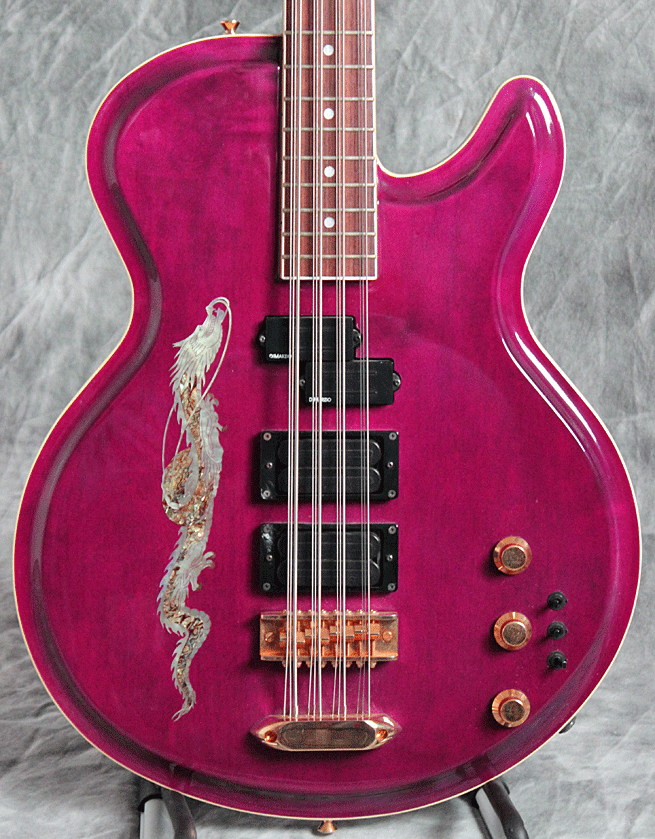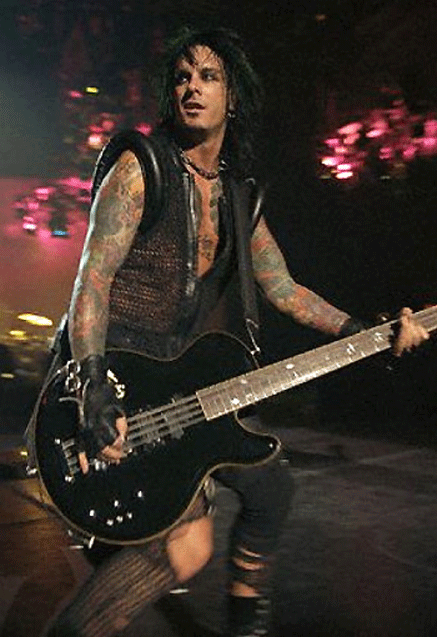Hiroshi Kid’s Guitar Company
hiroshi kids 12-string basses
Hiroshi Kid’s signature on the back of the headstock of a replica Gibson Flying V guitar.
Kid’s 12-string basses were made in Tokyo, Japan about 1992 by Hiroshi Kido, who went by the surname Kid and did business as Kid’s Guitar Company. Kid was a respected high-end custom guitar builder who specialized in making quality replicas. Typically he would only make one or two guitars in any specific design. Kid retired from guitar building in 1999, possibly due to a stroke or other health reasons.
(Editor’s note: Our original information referred to the builder’s name as Hiroshigi rather than Hiroshi, however after seeing his signature we have updated our information.)
Hiroshi Kid’s ad from Guitar Magazine (Japan), June, 1992 issue.
As an example of his work, Kid made two copies of the triple-neck guitar that Chris Squire of the band Yes played every time the band performed the song “Awaken” from the album Going For The One. Squire wrote, “Originally, the triple-neck bass was made by an English guitar maker going under the name Wal. It was made for Rick Wakeman's bass player for the period of Rick promoting his Journey to the Center of the Earth album, but at some point Rick gave it to me. However, this is not the bass that is currently being used as the original was sold in a charity auction to the Hard Rock Café back in the 1980's and can be seen in various HRC's around the world as they tend to rotate their collection. The current triple-neck bass that I use is a copy of the original made by Japanese guitar maker Kid's which comes on the road with me every time we perform ‘Awaken’.”
Kid made these 12-string basses in a special production run that has been reported to number fewer than 30 basses total. Only this one production run was made. Transparent Purple seems to be the most common finish, followed by Transparent Green.
The Kid’s basses were designed at a meeting at the House Of Blues in Hollywood, California using Tom Petersson's Hamer B12A 12-string bass with the Planet Hologram paint job as a starting point. That bass has a thinner headstock and neck than the standard B12A. The Hiroshi Kid’s 12’s were Tom Petersson’s 12-string basses of choice until he became involved with Chandler Guitars and switched to playing Chandler Royale 12’s.
The Hiroshi Kid's 12-string bass headstock with "Custom Built Electric Guitar" inscription. The “Kids” name is found either centered between the tuners or perpendicular on the end of the headstock.
Headstock of the Green Hiroshi Kids 12-string bass once owned by Nikki Sixx.
Kids 12-string basses are 34” long scale. They weigh nearly 14 pounds. These basses are frequently referred to as “Dragon Basses” because of the dragon designs.
Green Hiroshi Kids 12-string bass once owned by Nikki Sixx.
Gotoh 510 Bass tuners.
8-saddle bridge and 12-hole tailpiece.
A hardshell case was included with each Hiroshi Kids 12-string bass.
Kids 12-string bass gallery
Different pick-up types were used along with different colored caps on some of the pick-ups, which makes each Kids 12-string bass a little different from all the others. We have not seen any two Kids 12’s that were identical.
Tom Petersson’s stolen Kids 12-string bass
This bass was stolen from Tom Petersson during a tour of Japan but he was reunited with it in 2005.
The Kids 12 just before it was returned to Tom Petersson.
Another Petersson Kids 12
This is the first Kids 12-string bass played by Tom Petersson, now owned by Lance Dierker.
This Kid's 12 has a hole that was cut to be used as a truss rod adjustment but then abandoned.
“Tom Peterson” name plate covers the hole…
... but the name plate on this first Tom Petersson bass had his surname misspelled. This error was reported to have been corrected on the other Petersson basses.
Tom Petersson autographing this bass, with his signature shown below. When Lance told Tom that he would never sell this bass and it would go with him to the grave, Tom signed it, "R.I.P. Tom Petersson".
Tom Petersson’s signature.
Dragon designs
It is possible that each Hiroshi Kids 12-string bass has a slightly different dragon.
Customized Hiroshi Kids 12-string Bass
Hiroshi Kid’s 12-string bass with custom Japanese characters. (ex. Nikki Sixx)
Nikki Sixx, bassist for Mötley Crüe, replaced the Dragon inlay with custom Japanese kanji characters added to both the body and fingerboard of his Black Hiroshi Kid’s 12-string bass. He played this bass live on the Generation Swine, Entertainment or Death, and Maximum Rock tours.
Japanese tattoo artist Horiwaka used the traditional Tebori method when he tattooed these characters onto Nikki Sixx’s chest in Tokyo, Japan on April 29, 1997. The tattoo stands for “Spirit, Soul, Desire, and Passion for Life”. Sixx liked the tattoo so much that these same characters were inlaid onto the body of his 12-string bass.
The bass body inlays match Nikki Sixx’s chest tattoo.
Nikki Sixx displays his tattoo.
The inlaid characters on the fingerboard,
Nikki Sixx with his customized black Hiroshi Kid’s 12-string bass, published in the November, 1998 issue of Burrn! magazine in Japan.
Nikki Sixx’s 2018 Facebook post about this bass.
Kid’s 12-String Bass Review
By Doug Yeiter
This is one of the best sounding instruments I've ever heard. Its mahogany body / maple top, 3-piece flamed maple neck and rosewood fingerboard produce a deep rich tone. But this tone comes at a price - it's easily twice as heavy as any other bass I own. It's a full 34" long scale providing increased sustain and a piano like ringing tone. Even with just the four fundamental strings it sounds amazing. The 1¾" nut width provides for perfect string spacing (for me anyway).
Doug Yeiter from Tauranga, New Zealand and his Hiroshi Kids 12-string bass.
For electronics, it has a strangely simple setup consisting of three DiMarzio's, one p-bass and two humbuckers. I can't find any model numbers on any of them. Each has it's own volume and on / off switch. All gold heavy duty hardware (weight was apparently of no concern) and dual truss rods help to keep tune very well and provides a very solid feel. I did need to make a few adjustments when I first got it, but that's it.
The finish work is superb, very intricate work on the abalone dragon. No finish flaws, orange peel, etc., it’s very smooth. The combination of the green finish, gold hardware and the abalone dragon seemed a bit much at first, but they've grown on me. All in all I love this bass, the sound, the look and the feel. I couldn't ask for anything more. Definitely not for the meek (or the weak).



















